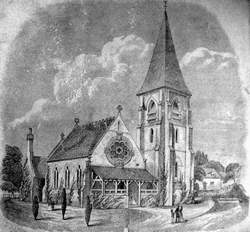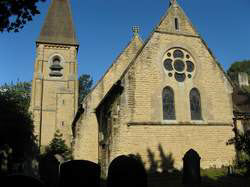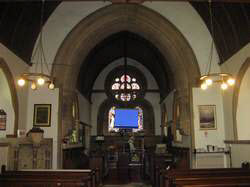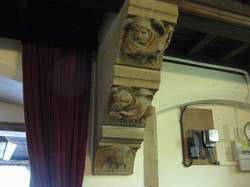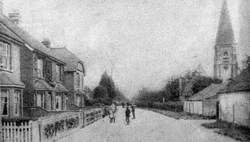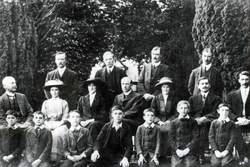Abandoned Communities ..... Lowfield Heath
By far the most splendid building, and the only building still in existence, was the church, dedicated to St Michael and All Angels. It opened in 1868. The church itself and its interior decoration were designed by William Burges. It is not as flamboyant as Burges' more well known interiors at Cardiff Castle, the chapel of Worcester College, Oxford, or St Mary's, Studley Royal, but it contains many wonderful things.
Today the church is used by the Seventh-day Adventist Church. Large congregations attend services every Saturday.
An important business was created by the Cheal family in 1871. Joseph and Alexander Cheal developed nurseries on land south of the village, just beyond the windmill. While Alexander concentrated on the nurseries themselves Joseph began to supply a garden landscaping service that in due course had contracts across the whole of Britain. The business remained within the Cheal family, Wilfred Cheal, grandson of Joseph and Alexander, taking it over after the Second World War.
The area around the village was liable to flooding when the river Mole and its tributaries overflowed. According to Charles Harper there were memorable floods in October 1891. Highways became rushing torrents, and along the nut-brown flood floated the remaining apples from orchards, with trees, bushes, and hurdles. Postmen on their rounds were reduced to wading, and thence to horseback and wheeled conveyances. During similar floods in February 1897 the dedication of an organ at the church in Lowfield Heath had to be postponed as the roads were under four feet of water. At a later date Winifred Kemp recorded that during floods very few children were able to get to school. If she looked out of her bedroom window she could see nothing but water, and if the front door was opened the water would run round the house like a river. Her father built a bridge so that he could go to work on a local farm and get any necessary shopping.
Winifred Kemp's recollections appear in Lowfield Heath Remembered by Jean Shelley, 1984. This book is a mine of information about Lowfield Heath. It is now hard to find a copy, but please get in touch with me if you would like to see it.
Other businesses developed with the growth of motor traffic. The road through Lowfield Heath, by the 1920s called the A23, became increasingly busy. Arthur Dudman opened a vehicle servicing garage, and his brother Ernie Dudman had a haulage company. Mr Plumridge (first name not known to me) began his career as a chauffeur, but later established a garage in the building formerly Mitchell's Tea Room. In due course he started to provide a coach service, building a larger garage for his coaches on the northern edge of the village on the west side of the A23, a site that now lies beneath Gatwick airport.
A school opened in Lowfield Heath in 1868, the same year as the opening of the church. The original school building was on the main road, a short distance north of the White Lion. Around 1911 a new building with three classrooms was erected at the eastern end of Church Road, just beyond the houses on that road. One person who was able to remember the school before it moved was Ethel Randall, formerly Ethel Jordan. The teacher, Miss Rowlands, had respiratory problems, and Ethel was called upon, while still at school, to stay overnight at County Oak with Miss Rowlands and then push her to school in a Bath chair. Later Miss Rowlands moved into the village, but Ethel continued to care for her until she died in 1914, still in her 30s.
Today the church is used by the Seventh-
An important business was created by the Cheal family in 1871. Joseph and Alexander Cheal developed nurseries on land south of the village, just beyond the windmill. While Alexander concentrated on the nurseries themselves Joseph began to supply a garden landscaping service that in due course had contracts across the whole of Britain. The business remained within the Cheal family, Wilfred Cheal, grandson of Joseph and Alexander, taking it over after the Second World War.
The area around the village was liable to flooding when the river Mole and its tributaries overflowed. According to Charles Harper there were memorable floods in October 1891. Highways became rushing torrents, and along the nut-
Winifred Kemp's recollections appear in Lowfield Heath Remembered by Jean Shelley, 1984. This book is a mine of information about Lowfield Heath. It is now hard to find a copy, but please get in touch with me if you would like to see it.
Other businesses developed with the growth of motor traffic. The road through Lowfield Heath, by the 1920s called the A23, became increasingly busy. Arthur Dudman opened a vehicle servicing garage, and his brother Ernie Dudman had a haulage company. Mr Plumridge (first name not known to me) began his career as a chauffeur, but later established a garage in the building formerly Mitchell's Tea Room. In due course he started to provide a coach service, building a larger garage for his coaches on the northern edge of the village on the west side of the A23, a site that now lies beneath Gatwick airport.
A school opened in Lowfield Heath in 1868, the same year as the opening of the church. The original school building was on the main road, a short distance north of the White Lion. Around 1911 a new building with three classrooms was erected at the eastern end of Church Road, just beyond the houses on that road. One person who was able to remember the school before it moved was Ethel Randall, formerly Ethel Jordan. The teacher, Miss Rowlands, had respiratory problems, and Ethel was called upon, while still at school, to stay overnight at County Oak with Miss Rowlands and then push her to school in a Bath chair. Later Miss Rowlands moved into the village, but Ethel continued to care for her until she died in 1914, still in her 30s.
Two
The church of St Michael and All Angels.
The church in July 2011, from the east.
The interior of the church
One of the consoles supporting the gallery, depicting angels playing musical instruments.
Memorial to William Burges’ dog, killed when it ran into the road after a ball during construction of the church. The memorial lies between the front entrance and the tower.
Church Road around 1910
The church choir in 1912.
This photograph comes from Jean Shelley’s book Lowfield Heath Remembered.
Please get in touch with me if you would like to know the names of any of the people in group photographs in this section.
